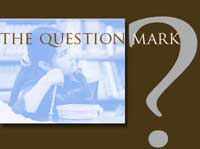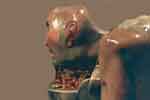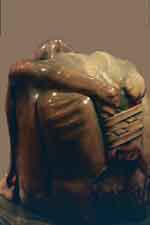Please feel free to e-mail this article to a friend, a principal, a parent, a colleague, a teacher librarian, a college professor, a poet, a magician, a vendor, an artist, a juggler, a student, a news reporter or anyone you think might enjoy it. Other transmissions and duplications not permitted. (See copyright statement below).
|
|
|
Some images governments may wish to hide and others they may wish to adjust.
Visual literacy involves the interpretation of available images, but it also means asking what may be missing or intentionally hidden from view. If we do not question the images we are shown and ask about those not shown, we are vulnerable to perception management1 as well as spin and propaganda.
As this article was written, Google gained notoriety for substituting satellite images of pre-Katrina New Orleans for current images showing devastation remaining long after the hurricane. The AP used the title, " House panel: Why did Google 'airbrush history?'" for its article (article).
A good question. Was the true New Orleans after the flood too harsh a reality?
In a democratic society, all citizens need be alert to such airbrushing. They need to ask what (or who) is missing.
A picture is worth a million words!
Inflation has hit the image business big time as we must edit the old saying from a thousand words to a million or a billion words. But sometimes a missing image is worth even more. "Out of sight is out of mind." If we cannot see "collateral damage," maybe it didn't happen? If we have no image of torture by water (waterboarding), maybe it isn't so bad?
Those who control the flow of images can hope to control the minds of the populace, convincing citizens to support or oppose a war.
In the 1960s and 1970s, three iconic images helped to turn a majority of the American people against the war in Vietnam:
-
Flag draped coffins (photo)
- Summary execution with pistol to head of prisoner (photo)
-
Young girl fleeing napalm (photo and story)
Recognizing the power of such images to undermine national resolve, the Pentagon began the invasion of Iraq with new policies, one of which was to block the photography of flag draped coffins. The public reason provided was respect for the families, but this censorship of images was an example of perception management, a term coined by the Pentagon to avoid Darwellian words like propaganda. (photo) Despite the euphemism, such control of images is a form of propaganda. It is mind control - part of an effort to sanitize an invasion and occupation, making it seem relatively painless.
When government officials failed victims of Katrina and dead bodies floated in the streets, the Bush Administration tried to block photography of the bodies until CNN brought suit. Images of dead bodies undercut the administration's claims of caring and effective action. (article)
Despite such efforts to control the flow of images, new technologies like cell phone cameras have led to the leaking of images extremely embarrassing to the Administration and the group running Iraq, as photographs of prisoner abuse and Saddam's hanging conflicted harshly with the images the governments wished to project.
What is waterboarding?
| Torture is thoroughly unAmerican, right? Or it was until 9/11, Afghanistan, Iraq and the Bush administration? Or can we find examples further back in our history? Lynchings, for example? Or Indian massacres?
While the Bush Administration protests that it engages in robust interrogation but not in torture, it is playing games with both the words and the truth, masking violations of international treaties and actions many consider to be war crimes. As this article was being written, former CIA Director George Tenet was maing the rounds of talk shows promoting his memoir, still maintaining the CIA did not do torture. (article)
Because the torture is hidden and the techniques are hard to imagine (or picture), the general public finds it hard to understand what is going on. Conducted in dark places and sometimes outsourced to nations with longer histories of torture, tactics like waterboarding are laughed off by Vice President Cheney as if it were a matter of dunking for apples - a little Halloween prank.
Note: CBS News reported on February 18, 2005 that since 9/11 the CIA has been using "extraordinary rendition" to outsource torture of suspects - sending them to other countries like Syria and Egypt where robust is very robust. (article) How much of this has happened has been kept secret.
|
This is what waterboarding looks like . . .

To see the above photograph of waterboarding from Cambodia's Tuol Sleng Prison, click here.
|
A dunk in water?
VP Cheney's words during the interview quoted below (full text) are chilling for the way he makes light of this practice. The VP is minimizing. He is condoning torture while laughing it off and pretending otherwise. He is playing down the horror. Along with George Tenet and President Bush he is distorting truth. With no images in mind to undercut their minimizing, the public has a hard time realizing the misrepresentation.
-
Q (section deleted) And I've had people call and say, please, let the Vice President know that if it takes dunking a terrorist in water, we're all for it, if it saves American lives. Again, this debate seems a little silly given the threat we face, would you agree?
THE VICE PRESIDENT: I do agree. And I think the terrorist threat, for example, with respect to our ability to interrogate high value detainees like Khalid Sheikh Mohammed, that's been a very important tool that we've had to be able to secure the nation. Khalid Sheikh Mohammed provided us with enormously valuable information about how many there are, about how they plan, what their training processes are and so forth, we've learned a lot. We need to be able to continue that.
-
(section deleted)
- Q Would you agree a dunk in water is a no-brainer if it can save lives?
THE VICE PRESIDENT: It's a no-brainer for me,
but for a while there, I was criticized as being the Vice President "for torture." We don't torture. That's not what we're involved in. We live up to our obligations in international treaties that we're party to and so forth. But the fact is, you can have a fairly robust interrogation program without torture, and we need to be able to do that.
And thanks to the leadership of the President now, and the action of the Congress, we have that authority, and we are able to continue to program.
Images from Argentina's Past -
A dunk in water is torture!
When you see a man with his hands tied behind his back, his head just emerging from a bucket of water, his eyes bulging and his chin dripping with yellow water, a dunk in water seems very much like torture.
Mr. Cheney's joking about water torture places him in evil historical company.
Torture is no joking matter.
|
|
|
The Vice President's words and actions betray basic American values of decency and lower the standards of American practice to those of the barbaric and horrific enemies he hopes to vanquish. |
El Mudo
73.5 x 79 x 102 cm
Polyester resin and pigments
©1973 Juan Carlos Distéfano, all rights reserved.
Reproduced here with permission of the artist
and the cooperation of the MNBA,
The Museo Nacionale de Bellas Artes
in Buenos Aires, Argentina
|
In permitting, condoning and encouraging such torture under the term "fairly robust interrogation program," he and the President have disgraced the American nation and violated the international treaties they claim to have honored. They have "stooped to conquer."
El Mudo (The Mute) - A man being tortured with water in Argentina
|
These images are published here with permission of the artist,
but are copyrighted. Information on possible use
is provided below. Click on an image to enlarge.
|
|
|
|
|
|
|
|
|
|
|
|
|
For information regarding use of these copyrighted images, contact
Dunk?
The VP's choice of words is obscene. The images above convey the truth of torture by water with an impact no words could manage. But sculpture, being three dimensional, is difficult to capture in photographs, so a gallery is required to convey the horror of the piece as seen from many angles. The reader is urged to open each image to its largest size, noting how the impact grows when enlarged. Walk around the statue with your mind's eye as if you are in the Museo in Buenos Aires.
El Mudo - The Mute
The artist gave the sculpture a title that can mean several different things. Is the man silent because he is refusing to give information? Or is he silent in the sense of being unheard from? Has he disappeared? Has he gone missing?
The Disappeared - los desaparecidos
Back in the 1970s in the years after the above sculpture was created, Argentina suffered through years of torture and dictatorship that led to the "disappearance" of some 30,000 citizens, some of whom were dropped into the ocean from airplanes, never to reach land again. The period from 1976 to 1983 is known as Argentina's Dirty Wars.
Missing people? Missing images?
Does torture cease to exist as long as it is hidden from sight?
1. Perception Management - Definition (Source is quoted below is AllExperts.Com)
-
Perception management is a term originated by the U. S. military. The U. S. Department of Defense (DOD) gives this definition:
perception management—Actions to convey and/or deny selected information and indicators to foreign audiences to influence their emotions, motives, and objective reasoning as well as to intelligence systems and leaders at all levels to influence official estimates, ultimately resulting in foreign behaviors and official actions favorable to the originator's objectives. In various ways, perception management combines truth projection, operations security, cover and deception, and psychological operations.
This would appear to include propaganda (which Wikipedia defines as "a specific type of message presentation, aimed at serving an agenda") as well as other activities. It is clear from the definition that unlike Public diplomacy, perception management is specifically intended to include the use of deception; that is, perception management is not supposed to be limited to the dissemination of truthful information.
|
|
|
|











